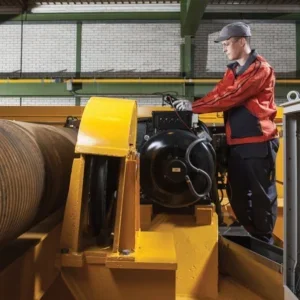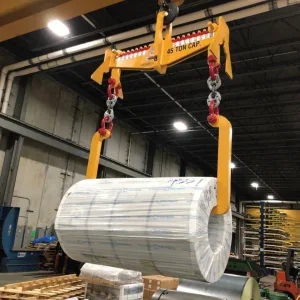The patent states that the problem of cable binding has been addressed with limited success by the prior art, and refers to 13 earlier patents. These include the Carter H Arnold US patents in which, it says, the rope is subjected to sudden changes in direction which tend to increase bending stresses.
In addition the means of transferring the rope from one winding to the adjacent winding must be relatively strong to withstand the relatively high tensions in the rope, thus increasing the costs of manufacture and possibly resulting in relatively high friction losses.
The Massell patent is a continuation-in-part of Fred E Ahlbin’s application Ser. No. 827,639 of 1959, now abandoned. The patent states that prior experience has shown that cable, even in small diameters, cannot be wound up consistently on reel with a core barrel or tread less than three inches (76mm) in diameter. Consequently, when a strained or worn cable is wound up on drums or reel barrels of small diameter, without suitable guiding confinement the turns frequently skew, and the cable kinks and tangles up on the drum during winding.
This may also be a problem on large drums. The patentees claim that, although complicated and costly travelling guiding devices have had a degree of success in heavy winch equipment for large cables, it is not practical to use such devices in economical winch structures for smaller cables.
The new patent’s objectives include the minimising of these problems to a practical degree, and also to provide a simple means of guiding small-diameter cable (around 5/32 inch – 4 mm) which is economically produced by mass manufacturing. The guiding requires no transverse travelling parts whilst laying down cable on reels orderly in successive cable turns.
Consequently this patent’s objectives include the improvement of the deficiencies in prior patents of the art, and also to provide an improved cable winder guide for a retainer resiliently engaging the cable and maintaining the cable within a helical groove.
What it is
The apparatus comprises a cylindrical drum with a central shaft mounted on two journals. A drive is provided to rotate the drum about the shaft. A helical groove is defined in the cylindrical surface of the drum for retrieving and releasing the cable upon rotation of the drum. A cable retainer is provided to resiliently engage the cable when the cable is located in the helical groove of the drum, so maintaining the cable within the groove.
Specifically the helical groove on the drum has a depth greater than one half and less than three-quarters of the cable diameter.
The retainer should have a substantially semi-cylindrical concave shape with a diameter greater than the drum diameter and less than the drum diameter plus on cable diameter.
How it works
Fig 1 illustrates a cable winder guide as invented as in a boatlift assembly as an example. It includes a horizontal support member (13) fixed to a vertical support member (14). The cable winder guide comprises a cable retainer (20) and a cylindrical drum (30), with the cable retainer fixed to the horizontal support member. The drum is fixed to a central shaft (5), and has a helical groove (40) in the drum’s cylindrical surface. The shaft is supported from the horizontal support member by journals (16 and 18). A drive (60) comprising an electric motor and reduction gearing rotates the shaft, preferably bidirectionally. Other drive systems can be used.
Fig 2 is an isometric view of the cable winder guide with the cable retainer ‘exploded’ away to show grooved cable drum which is, preferably, fabricated from a non-corrosive material, such as aluminium. The inner diameter of the drum is substantially equal to that of the shaft to which it is fixed. The first end (11) of the cable (10) is fixed to the first end (31) of the cylindrical drum by the helical groove.
The cable retainer is formed of a resiliently deformable material such as a polymeric material (for example, a mixture of polyethylene and polypropylene). It is located immediately adjacent to the cylindrical drum enabling it to resiliently engage with the cable to maintain it within the helical groove, aided by the correct semi-cylindrical inner diameter of the retainer.
Fig 3 is a longitudinal section through the centre of the cable drum and cable retainer. The inner diameter (34) of the cylindrical drum (30) is substantially equal to the outer diameter (52) of the shaft. The helical groove (40) defines the cylindrical drum outer diameter (42), an inner diameter (44) and the groove depth (46). The groove depth is in accordance with the cable diameter and is selected to be more than one half the cable diameter and less than three-quarters.
The diameter of the semi-cylindrical surface of the cable retainer is selected in accordance with the drum’s outer diameter, the groove depth and the cable diameter. This selected to be within the range of greater than the drum outer diameter and less than the drum outer diameter plus two times the cable diameter. Maintaining the diameter within these limits enables the cable retainer to maintain the cable within the helical groove of the drum.
The composition of the cable retainer is a critical balance between a material that is sufficiently tough to prevent premature wear on the cable retainer and sufficiently resilient to prevent wear on the cable. Various materials may be used (see above).
Fig 4 is a bottom view of part of the cable winder and retainer detail to better show the dimensional relationship between the drum, the helical groove, the cable and cable retainer. As seen in this figure the cable is held captive in the helical groove in full load as well as partial and no-load conditions.
The cable retainer resiliently engages the cable to ensure than it remains within the helical groove, and may deform slightly upon engagement with the cable. The resilient engagement by the cable retainer exerts an inward radial force on the cable greater than any outward force of the cable that may be generated by a loosening of the cable tension, or the like.
ABOUT THE PATENT
This article is an edited version of US patent No. 7,104,492. The inventors are George and Richard Massell of Clearwater Beach and Safety Harbour, Florida, respectively employees in production and sales, respectively, for Deco Power Lift, Inc., Safety Harbour, to which the patent is assigned. The patent refers to US Patent Provisional application No. 60/457,224, the subject matter of which it incorporates.
DISCLAIMER
This article is an edited version of the patent and may omit legally or technically important text. To see the full patent go to www.hoistmagazine.com/patents
MARKETING
Deco Power Lift, a specialist manufacturer of various designs of lift to remove watercraft from the water for storage, offers the patented development (known as the Cable Retention System – CRS) on all of these products, and it is a standard feature of their Beamless, Elevator and Concept CRS lists (optional on others). No other applications are available as yet.






